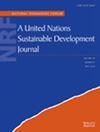The spatial pattern and association network of green finance development: Empirical evidence from China
IF 3.5
4区 社会学
Q2 ENVIRONMENTAL SCIENCES
引用次数: 0
Abstract
Green finance is a market‐driven approach to achieve the “double carbon” goal. However, the existing research predominantly focuses on the connotations and empowerment aspects of green finance. Notable regional disparities exist in China's financial markets and resource endowments, resulting in uneven levels of green finance development among various areas, significantly impeding the overall green transformation of the economy and society. In light of this, our paper explores the spatial patterns and association network of green finance development in China. The research findings indicate that: (1) The development of green finance in China exhibits an “east high, west low” spatial distribution pattern, with significant spatial clustering observed among neighboring provinces. The eastern region displays a “H‐H” clustering, while the western region shows an “L‐L” clustering. (2) The spatial correlation distribution of provincial green finance in China demonstrates an eastward concentration and westward dispersion trend, with strong correlation areas gradually expanding. Notably, Jiangsu, Zhejiang, Shanghai, and the Beijing‐Tianjin‐Hebei urban agglomerations lead nationally in attractiveness. (3) The external radiation capability of provincial green finance is progressively improving, with provinces such as Beijing, Hebei, Hubei, and Sichuan likely to occupy strategic structural positions, possessing greater development advantages. This study not only expands the theoretical scope of existing green finance research but also provides a practical reference for coordinating and achieving the high‐quality development of regional green finance from a practical perspective.绿色金融发展的空间模式与关联网络:来自中国的经验证据
绿色金融是实现 "双碳 "目标的一种市场驱动方式。然而,现有研究主要集中在绿色金融的内涵和赋能方面。中国的金融市场和资源禀赋存在明显的地区差异,导致各地绿色金融发展水平参差不齐,严重阻碍了经济社会的整体绿色转型。有鉴于此,本文探讨了中国绿色金融发展的空间格局和关联网络。研究结果表明(1)中国绿色金融发展呈现 "东高西低 "的空间分布格局,相邻省份之间存在显著的空间集聚。东部地区呈现 "H-H "聚类,西部地区呈现 "L-L "聚类。(2)中国省级绿色金融空间相关性分布呈现东向集中、西向分散的趋势,强相关区域逐渐扩大。其中,江苏、浙江、上海和京津冀城市群的吸引力在全国领先。(3)省级绿色金融对外辐射能力逐步提升,北京、河北、湖北、四川等省份可能占据战略性结构地位,具有较大的发展优势。本研究不仅拓展了现有绿色金融研究的理论视野,也从实践角度为协调和实现区域绿色金融高质量发展提供了现实参考。
本文章由计算机程序翻译,如有差异,请以英文原文为准。
求助全文
约1分钟内获得全文
求助全文
来源期刊

Natural Resources Forum
环境科学-环境科学
CiteScore
6.10
自引率
0.00%
发文量
24
审稿时长
>36 weeks
期刊介绍:
Natural Resources Forum, a United Nations Sustainable Development Journal, focuses on international, multidisciplinary issues related to sustainable development, with an emphasis on developing countries. The journal seeks to address gaps in current knowledge and stimulate policy discussions on the most critical issues associated with the sustainable development agenda, by promoting research that integrates the social, economic, and environmental dimensions of sustainable development. Contributions that inform the global policy debate through pragmatic lessons learned from experience at the local, national, and global levels are encouraged.
The Journal considers articles written on all topics relevant to sustainable development. In addition, it dedicates series, issues and special sections to specific themes that are relevant to the current discussions of the United Nations Commission on Sustainable Development (CSD). Articles must be based on original research and must be relevant to policy-making.
Criteria for selection of submitted articles include:
1) Relevance and importance of the topic discussed to sustainable development in general, both in terms of policy impacts and gaps in current knowledge being addressed by the article;
2) Treatment of the topic that incorporates social, economic and environmental aspects of sustainable development, rather than focusing purely on sectoral and/or technical aspects;
3) Articles must contain original applied material drawn from concrete projects, policy implementation, or literature reviews; purely theoretical papers are not entertained.
 求助内容:
求助内容: 应助结果提醒方式:
应助结果提醒方式:


